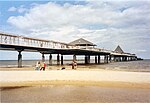Heringsdorf

Heringsdorf is a semi-urban municipality and a popular seaside resort on Usedom Island in Western Pomerania, Germany. It is also known by the name Kaiserbad (English: Imperial Spa). The municipality was formed in January 2005 out of the former municipalities of Heringsdorf, Ahlbeck and Bansin. Until January 2006, the municipality was called Dreikaiserbäder, literally meaning Three Imperial Spas, a reference to several vacation visits of the German emperor Wilhelm II until 1918. For the same reason, the fine sandy beach stretching about 12 km (7.5 mi) from Bansin over Heringsdorf to Ahlbeck and Swinemünde (nowadays a Polish spa), is also called Kaiserstrand (Imperial Beach). The continuous Baltic Sea beach of Usedom Island has an overall length of exactly 40 km (25 mi) and an average width of 40 m (130 ft). Tourism is the dominant economical sector of the Imperial Spas, with an increasing number of hotels and vacation homes every year.
Excerpt from the Wikipedia article Heringsdorf (License: CC BY-SA 3.0, Authors, Images).Heringsdorf
Küstengewässer einschließlich Anteil am Festlandsockel
Geographical coordinates (GPS) Address Nearby Places Show on map
Geographical coordinates (GPS)
| Latitude | Longitude |
|---|---|
| N 53.966666666667 ° | E 14.166666666667 ° |
Address
Küstengewässer einschließlich Anteil am Festlandsockel
18569 Küstengewässer einschließlich Anteil am Festlandsockel
Mecklenburg-Vorpommern, Germany
Open on Google Maps










